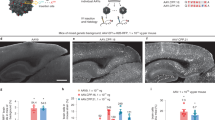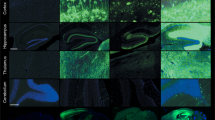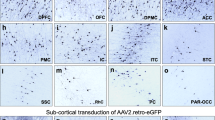Abstract
Adeno-associated virus serotype 2 (AAV2) has previously been reported to be a slowly uncoating virus in peripheral tissues, but persistence of intact vector in primate brain has not been explored. Because some neurological gene therapies may require re-administration of the same vector to patients, it seems important to understand the optimal timeframe in which to consider such repeat intervention. Surprisingly, convection-enhanced delivery of AAV2 into the thalamus of nonhuman primates (NHPs) resulted in robust staining of neurons with A20 antibody that detected intact AAV2 particles at ∼1.5 months after infusion. However, by 2.5 months, no A20 staining was visible. These data confirmed earlier findings of persistence of intact AAV2 particles in ocular and hepatic tissues. In order to probe the potential consequences of this persistence, we infused AAV2-human aromatic L-amino acid decarboxylase into left and right thalamus of three NHPs, with a 3-month delay between infusions. During that interval, we immunized each animal subcutaneously with AAV2 virus-like particles (empty vector) in order to induce strong anti-capsid humoral immunity. Various high neutralizing antibody titers were achieved. The lowest titer animal showed infiltration of B lymphocytes and CD8+ T cells into both the secondary and primary infusion sites. In the other two animals, extremely high titers resulted in no transduction of the second site and, therefore, no lymphocytic infiltration. However, such infiltration was prominent at the primary infusion site in each animal and was associated with overt neuronal loss and inflammation.
This is a preview of subscription content, access via your institution
Access options
Subscribe to this journal
Receive 12 print issues and online access
$259.00 per year
only $21.58 per issue
Buy this article
- Purchase on Springer Link
- Instant access to full article PDF
Prices may be subject to local taxes which are calculated during checkout





Similar content being viewed by others
References
Thomas CE, Storm TA, Huang Z, Kay MA . Rapid uncoating of vector genomes is the key to efficient liver transduction with pseudotyped adeno-associated virus vectors. J Virol 2004; 78: 3110–3122.
Stieger K, Schroeder J, Provost N, Mendes-Madeira A, Belbellaa B, Le Meur G et al. Detection of intact rAAV particles up to 6 years after successful gene transfer in the retina of dogs and primates. Mol Ther 2009; 17: 516–523.
Chirmule N, Propert K, Magosin S, Qian Y, Qian R, Wilson J . Immune responses to adenovirus and adeno-associated virus in humans. Gene Therapy 1999; 6: 1574–1583.
Calcedo R, Vandenberghe LH, Gao G, Lin J, Wilson JM . Worldwide epidemiology of neutralizing antibodies to adeno-associated viruses. J Infect Dis 2009; 199: 381–390.
Calcedo R, Morizono H, Wang L, McCarter R, He J, Jones D et al. Adeno-associated virus antibody profiles in newborns, children, and adolescents. Clin Vaccine Immunol 2011; 18: 1586–1588.
Ciesielska A, Hadaczek P, Mittermeyer G, Zhou S, Wright JF, Bankiewicz KS et al. Cerebral infusion of AAV9 vector-encoding non-self proteins can elicit cell-mediated immune responses. Mol Ther 2013; 21: 158–166.
Samaranch L, San Sebastian W, Kells AP, Salegio EA, Heller G, Bringas JR et al. AAV9-mediated expression of a non-self protein in nonhuman primate central nervous system triggers widespread neuroinflammation driven by antigen-presenting cell transduction. Mol Ther 2014; 22: 329–337.
Sanftner L . Striatal delivery of rAAV-hAADC to rats with preexisting immunity to AAV. Mol Ther 2004; 9: 403–409.
Peden CS, Burger C, Muzyczka N, Mandel RJ . Circulating anti-wild-type adeno-associated virus type 2 (AAV2) antibodies inhibit recombinant AAV2 (rAAV2)-mediated, but not rAAV5-mediated, gene transfer in the brain. J Virol 2004; 78: 6344–6359.
Peden CS, Manfredsson FP, Reimsnider SK, Poirier AE, Burger C, Muzyczka N et al. Striatal readministration of rAAV vectors reveals an immune response against AAV2 capsids that can be circumvented. Mol Ther 2009; 17: 524–537.
Li H, Lin S-W, Giles-Davis W, Li Y, Zhou D, Xiang ZQ et al. A preclinical animal model to assess the effect of pre-existing immunity on AAV-mediated gene transfer. Mol Ther 2009; 17: 1215–1224.
Hadaczek P, Eberling JL, Pivirotto P, Bringas J, Forsayeth J, Bankiewicz KS . Eight years of clinical improvement in MPTP-lesioned primates after gene therapy with AAV2-hAADC. Mol Ther 2010; 18: 1458–1461.
Wobus CE, Hügle-Dörr B, Girod A, Petersen G, Hallek M, Kleinschmidt JA . Monoclonal antibodies against the adeno-associated virus type 2 (AAV-2) capsid: epitope mapping and identification of capsid domains involved in AAV-2-cell interaction and neutralization of AAV-2 infection. J Virol 2000; 74: 9281–9293.
Bobo RH, Laske DW, Akbasak A, Morrison PF, Dedrick RL, Oldfield EH . Convection-enhanced delivery of macromolecules in the brain. Proc Natl Acad Sci USA 1994; 91: 2076–2080.
Fiandaca MS, Varenika V, Eberling J, McKnight T, Bringas J, Pivirotto P et al. Real-time MR imaging of adeno-associated viral vector delivery to the primate brain. Neuroimage 2009; 47: T27–T35.
San Sebastian W, Kells AP, Bringas J, Samaranch L, Hadaczek P, Ciesielska A et al. Safety and tolerability of MRI-guided infusion of AAV2-hAADC into the mid-brain of non-human primate. Mol Ther Methods Clin Dev 2014; 3 e-pub ahead of print 15 October 2014.
Zaiss A-K, Liu Q, Bowen GP, Wong NCW, Bartlett JS, Muruve DA . Differential activation of innate immune responses by adenovirus and adeno-associated virus vectors. J Virol 2002; 76: 4580–4590.
Lowenstein PR, Mandel RJ, Xiong WD, Kroeger K, Castro MG . Immune responses to adenovirus and adeno-associated vectors used for gene therapy of brain diseases: the role of immunological synapses in understanding the cell biology of neuroimmune interactions. Curr Gene Ther 2007; 7: 347–360.
Zirger JM, Puntel M, Bergeron J, Wibowo M, Moridzadeh R, Bondale N et al. Immune-mediated loss of transgene expression from virally transduced brain cells is irreversible, mediated by IFNγ, perforin, and TNFα, and due to the elimination of transduced cells. Mol Ther 2012; 20: 808–819.
Lowenstein PR . Input virion proteins: cryptic targets of antivector immune responses in preimmunized subjects. Mol Ther 2004; 9: 771–774.
McCraw DM, O'Donnell JK, Taylor KA, Stagg SM, Chapman MS . Structure of adeno-associated virus-2 in complex with neutralizing monoclonal antibody A20. Virology 2012; 431: 40–49.
Fiandaca MS, Forsayeth JR, Dickinson PJ, Bankiewicz KS . Image-guided convection-enhanced delivery platform in the treatment of neurological diseases. Neurotherapeutics 2008; 5: 123–127.
Krauze MT, Saito R, Noble C, Tamas M, Bringas J, Park JW et al. Reflux-free cannula for convection-enhanced high-speed delivery of therapeutic agents. J Neurosurg 2005; 103: 923–929.
San Sebastian W, Richardson RM, Kells AP, Lamarre C, Bringas J, Pivirotto P et al. Safety and tolerability of magnetic resonance imaging-guided convection-enhanced delivery of AAV2-hAADC with a novel delivery platform in nonhuman primate striatum. Hum Gene Ther 2012; 23: 210–217.
Su X, Kells AP, Salegio EAA, Richardson RM, Hadaczek P, Beyer J et al. Real-time MR imaging with gadoteridol predicts distribution of transgenes after convection-enhanced delivery of AAV2 vectors. Mol Ther 2009; 18: 1490–1495.
Acknowledgements
This study was supported by a grant to KSB from NIH-NINDS (R01NS073940-01).
Author information
Authors and Affiliations
Corresponding author
Ethics declarations
Competing interests
The authors declare no conflict of interest.
Additional information
Supplementary Information accompanies this paper on Gene Therapy website
Rights and permissions
About this article
Cite this article
Samaranch, L., Hadaczek, P., Kells, A. et al. Slow AAV2 clearance from the brain of nonhuman primates and anti-capsid immune response. Gene Ther 23, 393–398 (2016). https://doi.org/10.1038/gt.2015.87
Received:
Revised:
Accepted:
Published:
Issue Date:
DOI: https://doi.org/10.1038/gt.2015.87



